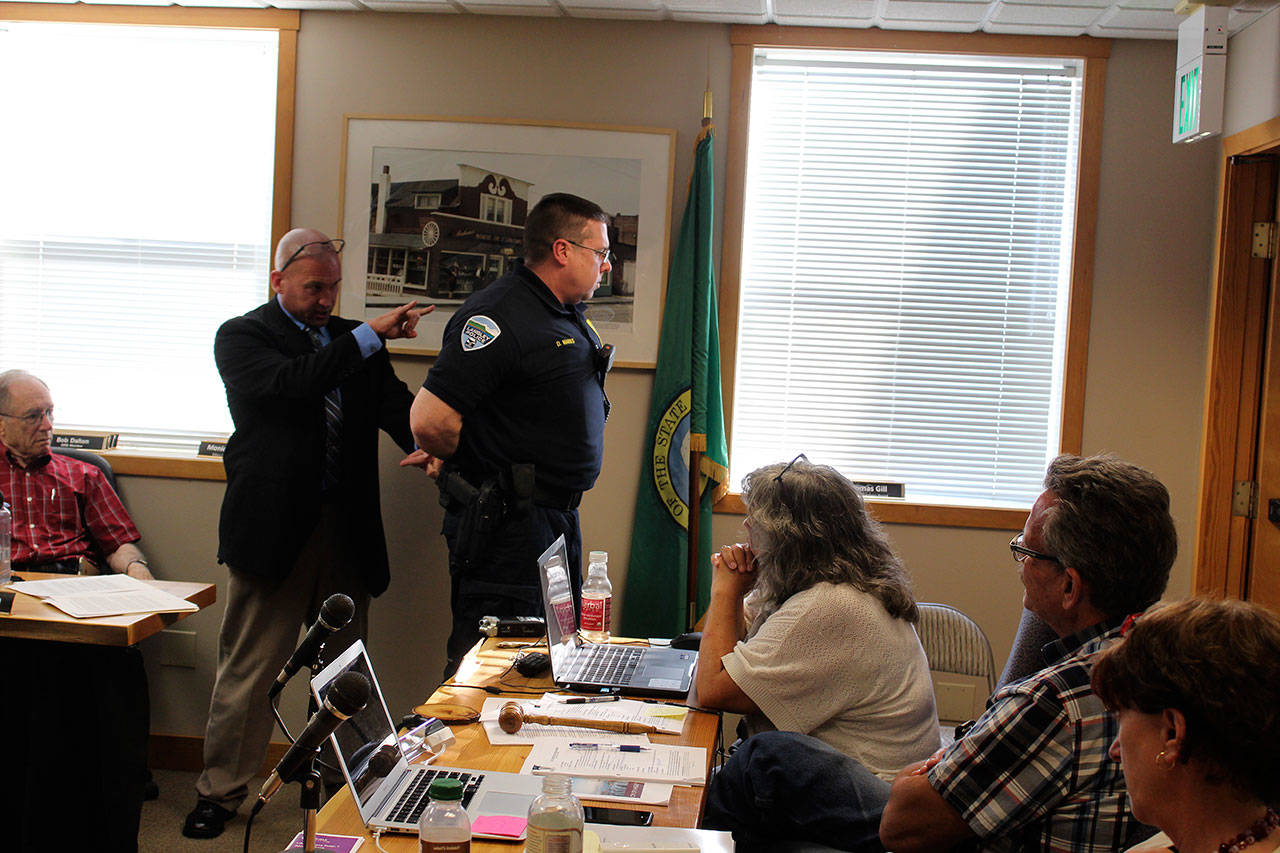Langley Police Chief David Marks didn’t apply excessive force or violate local law enforcement policy when arresting trespassing suspect Camren Procopio last November, use-of-force expert Glen Carpenter said at a city council meeting Monday.
Carpenter, a Pierce County sheriff deputy who is one of the state’s top tactical instructors for law enforcement trainees, was hired by Langley Mayor Tim Callison to review whether Marks violated city police procedures.
Reading from his 45-page report, Carpenter often referred to state and federal court decisions that set precedent and instances where officers were injured or killed in the line of duty.
Carpenter said he based his conclusion on previous investigations and a forensic review of all people involved in the incident: Marks, Procopio, Deputy Thomas Brewer of the Island County Sheriff’s Office and Langley Police Officer Mason Shoudy.
Brewer and Shoudy, who responded to the scene when Marks called for back-up, alleged that Marks used unnecessary and aggressive force when handcuffing Procopio and caused him to fall face first on the ground.
Marks, who has led the four-person department for four years, claims the suspect, who suffers from mental illness, was resisting arrest and threw himself to the ground.
“The takedown to the ground was not an intentional act,” Carpenter said. “It wasn’t intentional on the officer’s side. It was intentional on the individual’s side to go down to the ground.”
Carpenter’s review is the third government investigation of the Nov. 20, 2017 incident.
Washington State Patrol detectives conducted a criminal investigation into Marks’ actions after Brewer and Shoudy reported the alleged excessive use of force.
After reviewing those documents, Island County Prosecutor Greg Marks concluded that a jury would be unlikely to convict Marks of gross misdemeanor assault. But in his analysis, Banks rejected Marks’ contention that Procopio threw himself to the ground.
“Based on the aggressive tenor of the entire contact and the observations by the two officers, I conclude that it is highly unlikely that Mr. Procopio was responsible for his fall,” Banks wrote.
In a six-page memorandum, Banks wrote that although Marks’ behavior didn’t meet criminal standards, it didn’t meet expected standards of law enforcement officers, either.
“Chief Marks’ behavior was, even if only negligent, disturbing and well below the bar we set for professional police officers in our community,” Marks wrote.
Carpenter said previous reviews of the incident failed to take in Marks’ perception of the suspect and his nine-year history dealing with him.
From his numerous interactions with Procopio, Marks knew that he was erratic, usually carried a weapon and routinely resisted arrest by becoming a dead weight and falling to the ground, Carpenter said.
Brewer and Shoudy didn’t know the suspect’s history, which probably influenced their perception of what happened, he added.
Marks’ actions were in line with proper responses to what’s known as Level 1 use of force control tactics, the lowest level of force necessary to arrest and search a suspect and safely get him into a patrol car, Carpenter explained.
“All of Chief Marks tactics are considered Level 1 from the Criminal Justice Training perspective, Level 1 from constitutional law perspective and Level 1 from department policy perspective,” he said.
Carpenter asked Marks to the front of the room several times to help demonstrate proper arrest and restraint techniques. Pulling Marks’ hands behind his back, Carpenter explained handcuffs will hurt “if the suspect tries to resist in anyway.”
Only one hand was handcuffed when Procopio suddenly dropped his other arm down. He could have been reaching for his bag, which hadn’t been searched, or he could have injured officers, Carpenter said.
When suspects actively resist arrest or pose an immediate threat, officers can use pepper spray, Taser, baton or even strike tactics, but Marks didn’t employ any of these methods, Carpenter pointed out.
“He relies on his strength, keeps a hold of one hand and grabs the individual’s hand to bring it back to be handcuffed,” he said.
“What I can tell you is this particular Level 1 technique for handcuffing is exactly what we teach, it’s textbook,” he added. “Honestly, for junior officers to witness this and not understand what was going on, they forgot what was taught at state academy.”
Carpenter reviewed Procopio’s arrest history and jail records. He cited reports of domestic violence, disorderly conduct, criminal trespass and sharing marijuana with an underage boy and of how Procopio often went limp and dropped to the ground when being arrested.
Records show Procopio repeatedly attacked staff in jail. In 2015, he was convicted of assault in the third degree for attacking two corrections officers, one whom suffered a career-ending knee injury, Carpenter said.
Among other jail behavior cited was food throwing, feces smearing and the fashioning of weapons. He threw water in the face of a guard and kicked another in his testicles.
“He has a long history of assaulting police officers and takes all opportunities to do it. He’s known to be armed,” Carpenter said. “He’s known to have mental health disorders.”
Carpenter was asked if he had reviewed any other allegations of inappropriate behavior against Marks. He replied there were none in his file and that his performance evaluations in the past 14 years were above average to excellent.
Callison reiterated he hired Carpenter to review “this specific instance and whether or not the chief violated own own internal policies with his actions.”
Council member Peter Morton informed Carpenter that councilors have been inundated with emails from residents reporting other instances of questionable and aggressive behavior by Marks and that’s what they are wrestling with.
“This is the only incident involving Chief Marks that we know of that has been investigated,” Morton said. “There may be other incidents that are allegations.”
Callison said his administrative review and decision will be based on all the reports and “circumstances leading up to this.”
“I have to consider in totality and context the other information that’s come to light since,” he said.



